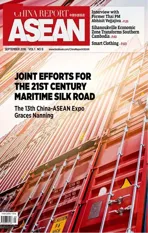Meat Producers Shift Focus to Instant Products
2016-11-23ByWangJiping
By Wang Jiping
Meat Producers Shift Focus to Instant Products
By Wang Jiping

Tracking the entire meat production process is a crucial part of ensuring food safety standards are met.
Instant noodles have been a part of the Chinese diet for decades. Cheap, convenient and fast, they are a common sight on train journeys in China and ofen a first-choice late night snack among Chinese consumers. However, the instant food industry in recent years has begun to diversify, and now encompasses much more than just instant noodles. Today, meat producers in China as well as ASEAN countries are investing heavily in instant meat products,looking to improve both meat quality and taste for consumers across the region and the world.
Food Safety First
A common concern related to instant meat is that of health and safety. Instant meat products in particular are thought to contain a large amount of chemical additives and preservatives, and eating healthy is a growing concern among people across the region. Therefore, instant meat producers prioritize healthy products.
Due to an increase in reporting on food safety by the media as well as the government, Chinese consumers' awareness of food safety has grown in recent years, and government food safety regulations are becoming more and more strict. According to spot checks carried out by the China Food and Drug Administration (CFDA), from 2004 to2015, 75 percent of Chinese meat products passed inspection.
Establishing a system of safe production is the number one priority of instant meat producers, said Wang Nan of Qingdao Chia Tai, a subsidiary of the Thai conglomerate Charoen Pokphand, while attending the 16th China (Beijing) International Meat Industry Exhibition. China, as a huge consumer of meat products, is an important place to do business in the industry.
To gain the trust of Chinese consumers, meat producers must obtain related international certificates and be cited as “one of the top 100 enterprises in slaughter and meat processing in China”. To obtain such status, producers must establish a work system that combines feeding, raising, slaughtering,processing and selling, which makes products fully traceable.
“Food safety is now a sensitive issue,” Wang said. “As a company that wants to develop sustainably in China, we must maintain self-discipline and make sure the customer knows our products are trustworthy and of high quality.”
Thanks to traceability systems,consumers can educate themselves on the origin of the food they eat. In addition, such systems also establish a strong logistics network and allow retailers to be selective in choosing where they get the products.
“If products are deemed to be unsafe by institutions like the CFDA,our company may receive a heavy punishment,” said Zhou Ji, administrative deputy manager at Pengcheng Food, a subsidiary of the Beijing Shunxin Agriculture Company. “It is difficult to rebuild a company's image in the eyes of consumers if something like that happens.”
Zhou said his company typically conducts tests at various layers of the supply chain and carefully chooses equipment for storage and transportation, as well as anti-staling agents that are needed to keep meat fresh while it moves from producer to retailer.

Halal food items on display at a supermarket in Xuchang, Henan Province.
Today, meat producers in China as well as ASEAN countries are investing heavily in instant meat products, looking to improve both meat quality and taste for consumers across the region and the world.
Diversification of Products
As technology relating to food production has improved, many producers are looking to branch out beyond canned meats or sausages.
“It is necessary for us to develop a variety of products that take into account the different types that consumers are afer,” said Li He, general manager of the Inner Mongolia Kerchin Cattle Industry, a Muslim meat producer. Li's company follows strict halal requirements in meat production, and has recently begun paying special attention to packaging and introduction of low-fat products. It has kicked off production of vacuum-sealed beef products that come in a variety of different flavors.
“Consumers remember tiny modifications like packaging and new products,” Li said. “In the future, if they realize they need that certain type of product, they will come back to us.”
Wang said that innovation has become a key part of the industry, but carries with it its own risks.
“Innovation is important, but needs to be carried out in an orderly way,”Wang said. Products like rice, noodles and pastry, along with meat, represent excellent opportunities for introduction of new products, he added.
“Innovation should be carried out only if it matches the real needs of the consumer,” Zhou said. Before approving the production of a new product,Zhou said his company provides taste tests to potential consumers, and changes ingredients in accordance to their responses.
“Though some innovations look good on paper, they turn out to be too costly or are only enjoyed by a very small group of consumers,” Zhou added.
In addition, a large number of companies present at the 2016 Beijing Meat Industry Exhibition said they are working to diversify instant meat products to meet the demands of children, especially those whose parents are Generation Y who tend to work full time.
“Providing safe and delicious instant meat products would be welcomed by parents like them, as they are so busy,” Zhou said.
